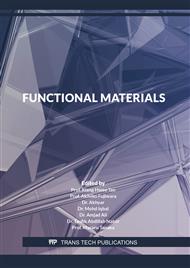p.3
p.11
p.17
p.27
p.35
p.47
p.53
p.61
Characterization of Magnesium Alloy AZ31 due to Thermal Oxidation Temperature
Abstract:
Magnesium and its alloy have good characteristics for implant materials. Increasing these characteristics is needed to be an excellent material. The objective of this research is to investigate the magnesium alloy AZ31 (Al: 3.07%; Zn: 1.05%) characteristics affected by thermal oxidation temperature. Investigated characteristics in this study were hardness, corrosion resistance, and microstructure. The temperature variations of thermal oxidation were 100, 200, 300, 400 °С. The Vickers micro-hardness decreased with increasing of thermal oxidation temperature and the as-received of Mg alloy had the highest Vickers micro-hardness. The lowest corrosion resistance occurred at 200 °С of thermal oxidation temperature but this corrosion resistant was higher than that at the as-received material. The microstructures of Mg alloy were looked cracked in their grains at the thermal oxidation temperature over than 200 °С. The cracks increased by increasing of the thermal oxidation temperature.
Info:
Periodical:
Pages:
11-16
Citation:
Online since:
August 2022
Authors:
Price:
Сopyright:
© 2022 Trans Tech Publications Ltd. All Rights Reserved
Share:
Citation:



